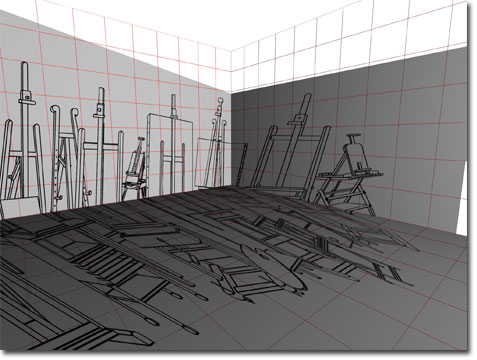Sala de Arte Público Siqueiros,
Nov 26, 2004 - Mar 20, 2005
Polanco, Mexico
Desapariencia (Taller)
by Luz Sepulveda
During the decades that conceptual art prevailed in the art world, drawing was scorned and everything related to representation, proportion or perspective was relegated a secondary status. It is nevertheless surprising that line is still being played with and is considered a vigorous and avant-garde proposal, as is the case with Regina Silveira’s (Porto Alegre, Brazil, 1939) work at the Sala de Arte Público David Alfaro Siqueiros in Mexico City. She has drawn lines that create an installation of objects that refer to an artist’s studio within the enormous white cube of the exhibition hall. The challenge of organizing a coherent exhibition within this space is enormous: the ceiling measures over seven meters in height; the small windows located in the upper part of the hall cast an indirect light on the space; and the huge walls that make up the space represent their own set of problems, without even mentioning the work itself. In other words, the artist had to see and study the architectural specifications of the cube to achieve the exact viewing dimensions; a critical component to her work. Silveira bases her work on principles of projecting perspectives taken from a polycentric angle, which gives the exhibition a more complete visial experience by including effects related to human scale, proportion and balance. The viewer’s sense of placement becomes distorted upon wandering through the hall, the walls and floor of which reflect the outlines of wooden forms, easels with canvasses, benches, shelves, artist’s palettes, and rags, among the other paraphernalia of a working studio. The shrunken forms-- at odd angles, lengthened, stylized and inclined-- give the sensation of the collapse of the outlying environment. That is, the floor seems to extend toward a vertical axis that is perpendicular to the horizon, to envelope us in a labyrinth of artists’ tools. The Venezuelan critic Celeste Olalquiaga considers the effect of psychastenia as typical to our reality, due to the enormous number of images and other advertising icons surrounding us. She declares that psychastenia is a disturbance in the relationship of a being with its surroundings, in which the spatial coordinates are determined by the body of the organism itself, which in turn becomes confused with the represented space. In the case of the work Desapariencia (Taller) by Silveira, the spatial coordinates are confused in a temporal infinity. The continuity of the lines, like the fragmentation of form, creates an amusing disorientation in the viewer, that, at the same time, seduces him like an endless space in which the difficulty and the pleasure lies in defining one’s own placement. The lines of the "studio" seem to extend themselves from our bodies yet fail to encounter a spatial boundary despite the proximity of the walls. This effect, a favorite among programmers of virtual reality games, allows us to reorganize our sense of position and posture within the space, and to keep our gravitational center in mind - an important detail in maintaining a sense of balance within the white cube.
|













